The Fourth Bi-Annual Workshop: Manuscript Culture in Ancient Egypt and China
发布时间:2019-01-18From 14th-18th January 2019, the International Center for the Study of Ancient Text Cultures (Renmin University of China) hosted the Fourth Bi-Annual Workshop for Ph.D. students and junior scholars, this time under the theme of “Manuscript Culture in Ancient Egypt and China,” at Renmin University in Beijing. Six distinguished scholars from the fields of ancient Egypt and China presented lectures in English to more than forty advanced graduate students from leading universities in China and around the globe.
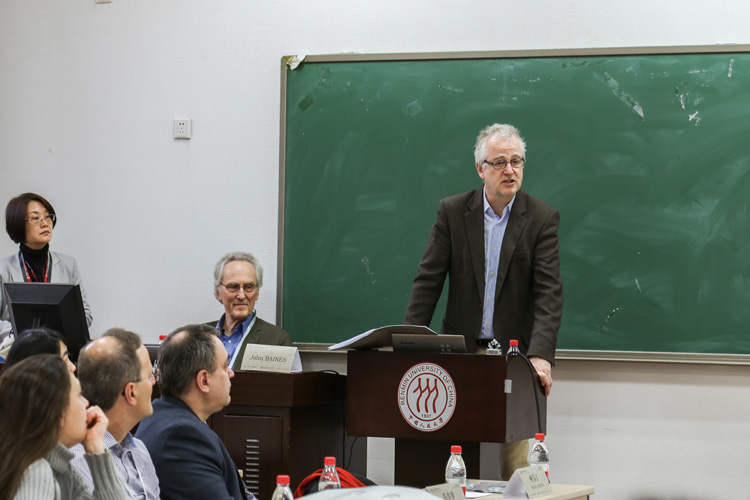
Professor Martin KERN
The workshop began from ancient Egypt by John Baines(University of Oxford) in the morning of 14th January, with the other five scholars interweaving their subjects of China and Egypt to inspire inter-cultural comparison and critical thinking in the audience.
Professor John Baines first introduced the multidisciplinary audience to the Egyptian language and the different stages of its development and writing systems and served as an introduction to the more specialized lectures on Egyptian manuscripts.
Then he turned to the preservation of records, pointing to an under- representation of the North in Egypt’s cultural output. Indeed, most papyri have been recovered from tombs in this area, where the conditions were generally more favorable for the preservation of this perishable material than the moist Nile Delta. Also, during the Dynastic Period most of the texts were found inside tombs, on the contrary the findings datable to the later period were concentrated inside temples or within different settlements especially in the Fayyum region and in cities as Oxyrhynchus. Although the transmission of literary texts in Egyptian history has suffered from such loss of testimonies, Professor Baines went through as many examples as possible of unearthed manuscripts to explain how the reality and development of ancient Egyptian literary activities can possibly be deciphered from the diverse representations of these texts. It is still possible to trace a huge varieties of texts such as rhetorical didactic texts (Instruction texts, Lamentations, Narratives, Love Poetry, Fables, Satire and Parody), school texts (kemyt, satire of the trades, miscellanies, exercises), books of knowledge (topographical lists, monographs, cult topographies, cosmographic and astronomical texts, books of the netherworlds, botanical treatise), books of expertise (medical texts, magical texts, mathematical texts, omen texts, books of good and bad days, dream interpretation3, astrological texts4). As to the public sources of possible year labels, annals, king lists, royal decrees and royal self-presentations, and so on, all of which are of fundamental importance to the history of Egyptian culture, however, were strikingly absent due to the lack of findings in archaeological excavations.
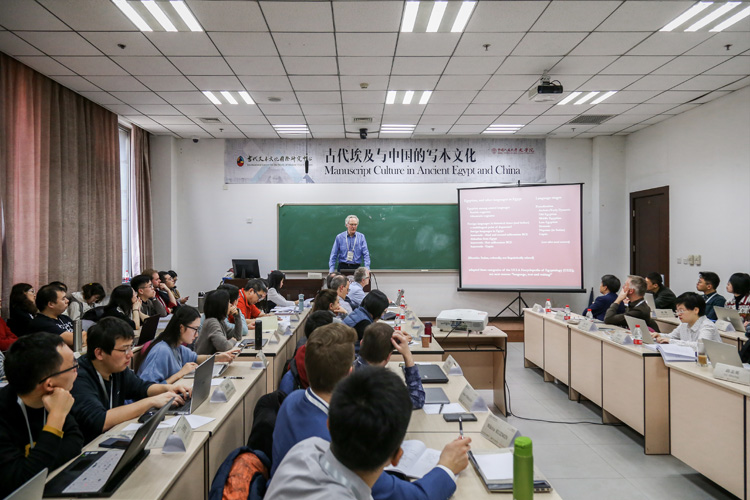
Professor John Baines
Professor Baines went on to broadly discuss how writing and images contain evidence of oral performances by examining texts such as a marriage ceremony and property settlement, which alluded to an oral setting for the proceedings, by listing witnesses. One of the strongest pieces for evidence of orality comes from the voice offering, carved in funerary stela and false doors, inciting the reader to recite this formula out loud for the deceased.
In Baines’ last lecture on diversification of script and usages in first millennium Egypt, he touched upon a number of subjects concerning the development of the Egyptian textual tradition from the 20th Dynasty (c. 1100 BCE) to the Roman period. One of the most significant events was that administrative everyday hieratic script evolved toward new types of script: abnormal hieratic and demotic. By introducing papyrus found in Fayyum, he pointed out that some of these manuscripts provoked the digression on the two types of words ordering: alphabetic and halham, the first one was nonexistent in Egypt before the Greco-Roman period, while the latter was recently found on an Egyptian ostracon of 15 c. BCE. He also presented some interesting examples of corrections, different demotic hands, and different types of pagination in Tebtunis papyri, and continued with an example of magical papyrus in Classical Egyptian written in Greek letters ("Old Coptic", 2nd c. CE) for the sake of the right pronunciation. At last, he mentioned some new uses of demotic script during the Greco-Roman period, such as the word-play, and then mentioned the latest hieroglyphic inscriptions in temples, which date from from the 3rd c. CE.
The second lecturer was Professor Ben Haring (Leiden University) on the topics of format and purpose of New Kingdom documentary texts, and identity marks and Pseudo-script in Theban Necropolis administration of New Kingdom Egypt. Haring noted that the administrative writing emerged earlier in Mesopotamia areas dating back to Uruk IV and III (ca. 3400-3000B). The hieroglyphs signals could be dated back to as early as around 34th-32nd centuries BCE and the hieratic around 29th-28th centuries BCE. By taking the Lahum papyrus as an example, on which people’s social activities and work arrangement were recorded, Haring showed how the administrative institution worked in the Middle Kingdom period. He explained that the hieratic ostraca and papyri from the site presently known as Deir el-Medina were the major corpus of administrative texts from the Pharaonic period. Some of these were the records of collective work such as journals, notes, the accounts of the daily supplements, distribution, deficit and presence list. Others were more about private business disputes, including accounts of payment, hire, debt, transfer, division. There were also plenty of juridical testimonies recording court or oracle proceedings, depositions and oaths. Several letters for official or private use were also found. Also, Haring analyzed the non-literary texts and their chronological distribution from Deir el-Medina and related sites. All these materials have been digitalized into a database for further research.
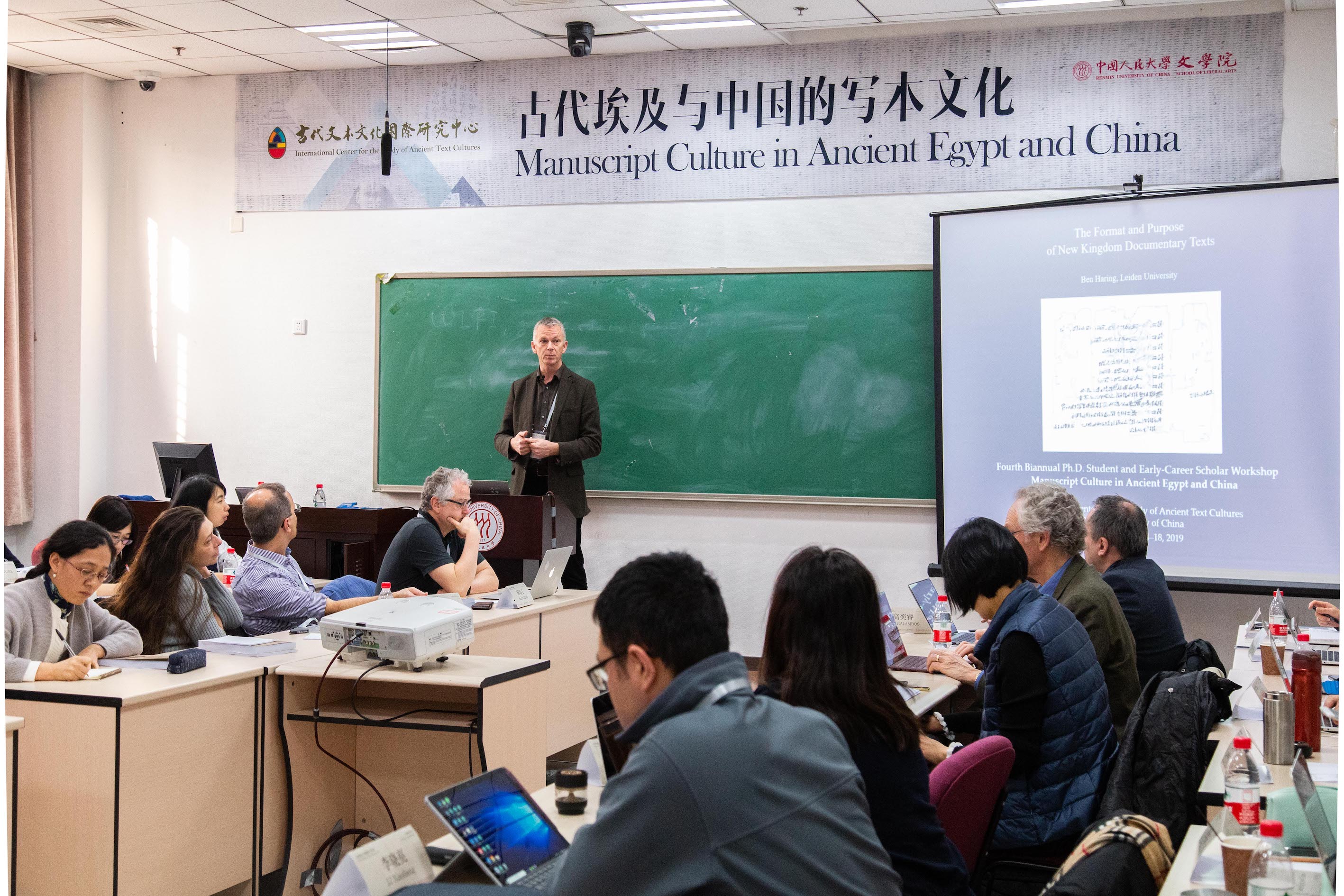
Professor Ben Haring
In his second lecture, Professor Haring pointed out that the role of written texts in society was very limited for no more than 1% of the population in pre-Hellenistic times and throughout Pharaonic history achieved full literacy in any type of script. Writing is only a part of a much more extensive spectrum of visual and material communication that includes many other types of systematic notation or sign systems, of which identifying marks were of great value. A particular well-attested system of identify marks was used by the workmen of the royal necropolis at Thebes during the Egyptian New Kingdom. Professor Haring then went through some of the samples of these marks. He concluded that the marks were important in the following four ways: they were identifications of the persons who made the marks; as a marking system through years, generations, centuries; recording practices of semi-literates; and type of non-scriptural but visual recording, among many others. Last, Haring suggested that such marks may not be essentially older than writing, hence they were not necessarily the starting points of the baricolage that resulted in the hieroglyphic and proto-cuneiform scripts. Yet it is very likely, that writing developed out of existing graphic codes.
Professor Maria Cannata (Free Scholar) went on to the topic of ancient Egyptian with her specific focus on the formats, uses, and range of Demotic Legal Texts (1st Millennium BCE). To begin with, she explained that under Amasis, Demotic became the official administrative and legal script and started to be used for literary texts from 4th century BC. The early Ptolemaic period is especially rich in demotic documentary of all kinds. Legal documents concern agreements between private individuals, they provide information on points of Law, as well as on social and economic life. The format of Demotic documents on papyrus varies from small scraps to complete rolls. Changes on legal texts can reveal traces of history processing during the period, as demotic documents regarding a sale had to bear a Greek note stating payment of relevant taxes from 264 B.C. onwards may tell how international relationships developed at the time.

Professor Maria Cannata
Professor Cannata listed ten ranges of private legal documents discovered in ancient Egypt, including 1. Marriage settlements and divorce documents; 2. Documents concerning Money – sale and sessions; 3. Exchanges; 4. Donations / Property transfers; 5. Divisions / Wills; 6. Partnerships; 7. Leases; 8. Loans; 9. Deeds of Obligation; 10. Deposits. She then went on to focus specially on Marriage Documents.
Stipulated between husband and wife, Professor Cannot suggested, a marriage document (deeds) was drawn up at any time during a marriage and would involve a certain cost, so that they may have been in use only among wealthier citizens. By categorizing these documents into three main groups, she noted that it was believed that there were two stages of marriage: loose marriage and full marriage. And the distinction between the three groups of documents were the diverse way that they deal with property, daily maintenance, heritage and children. Professor Cannata also pointed that ancient Egyptian law probably always admitted the possibility of divorce in case of adultery and when one or both parties wanted to separate. Ten examples of divorce documents survive from 542 until about 100 BC. In these the husband acknowledges that the woman is no longer his wife, that he has no more claims on her, and that she is free to marry again.
Back from the ancient Egyptian world, Professor Imre Galambos (University of Cambridge) took the audience to the ancient Chinese world of the material nature of manuscripts found in Dunhuang of the Medieval China. To help better understand the topic, he began with some examples containing scribbles, arguing that these phenomenon deserved more attention than being regarded as merely randomly written words and meaningless sentences, and a wholesale study of them would possibly make sense of these scribbles and utilize them to link manuscripts that may otherwise remain unconnected. Another important observation of his was that many manuscripts could be seen as associated with students, even though we do not have direct indication of this. He also encouraged his audience to go a step further to look at not only the main text, but also additional texts, such as scribbles on the verso. A study on documents of social and economic, rather than educational manuscripts, will also shed light to better understand the not entirely random scribbles: together they exhibit a pattern. His observations can be divided into three aspects: firstly, it is possible to identify additional manuscripts copied by students; secondly, it helps us to understand the social practice behind the production of these manuscripts; thirdly, it sheds light on educational practices, and forces us to reconsider what is an educational text: Should it be defined by its genre, or by its function?
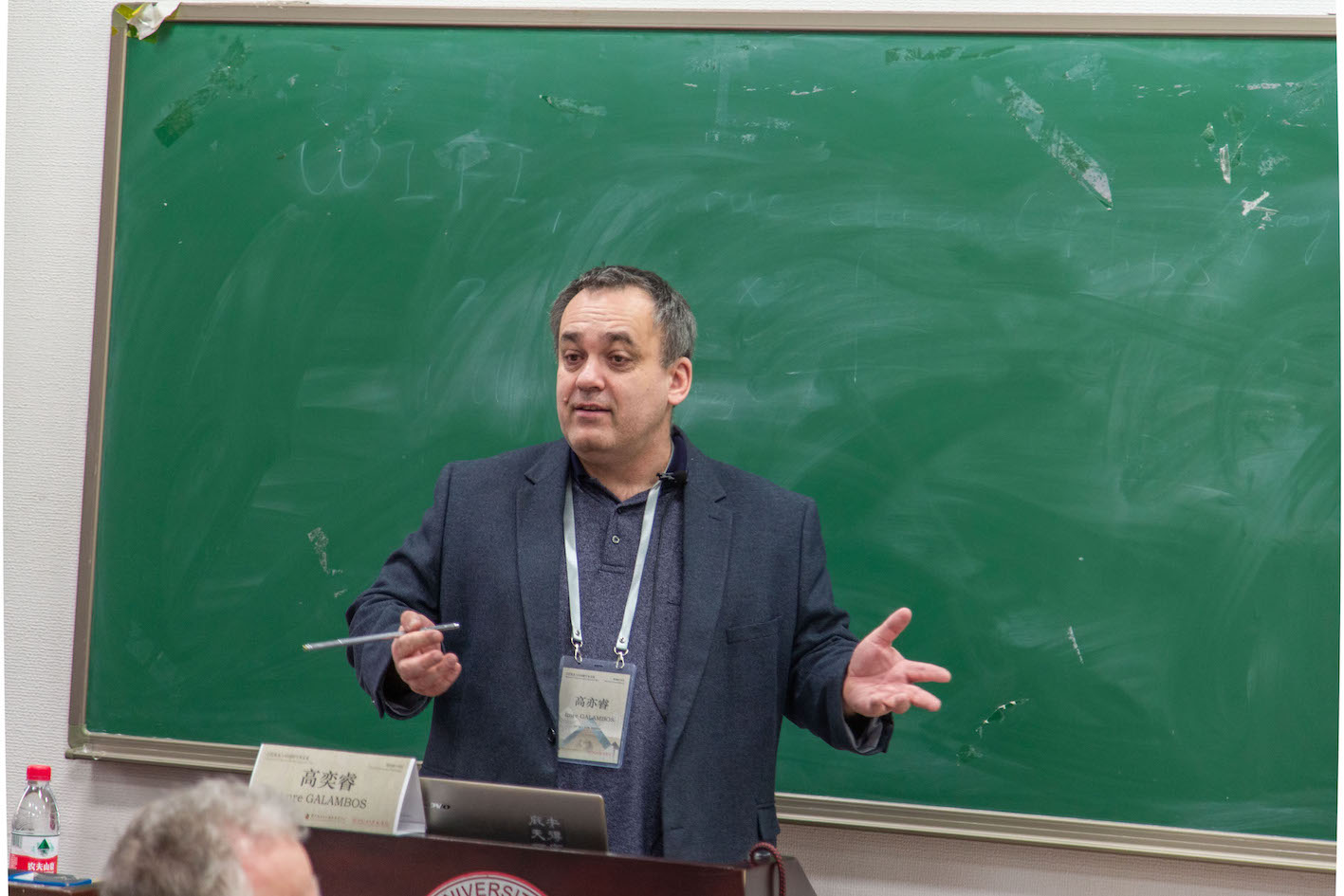
Professor Imre Galambos
In his second lecture, Professor Galambos presented his audience with the specific book format and codices that played a significant role in Dunhuang during 9th to 10th centuries, and focused on how this format originated and was used in Dunhuang. By pointing out the similarity in corners of folio between Dunhuang manuscripts (S. 5538 (1), the Diamond Sūtra, S. 6983, the 25th chapter of the Lotus Sūtra, and S. 5588) and Syriac texts preserved in Berlin, both either cut or rounded, he believed that the format was more likely the result of other foreign influences rather than Manicheanism or Nestorianism. The second part of the lecture moved to the discussion of the usage of such codices. He mainly compares two codices, S. 5531 and P. 3932. Both manuscripts are collections of short Buddhist sūtras, dharanis, and apocryphal texts. All these texts are thematically related since they all more or less address how to seek help from the Buddha or a bodhisattva to deal with current difficulties; at the same time, they are all very short. They are either short sūtras, or parts of a large sūtra, or simply a dharani spell excerpted from a sutra. Thus, a compilation of these relatively short texts enables the owner to carry it on his body or in his clothes. In this way, the Buddhist codex we found in Dunhuang was used probably as a talismanic object to protect the bearer. Professor Galambos also mentions that there are several compilations of texts that are made into concertina shapes, which is also a format easily carried by people.
Professor Chen Jian (Fudan University) focused on the diction and vocabulary changes in the transmission of ancient Chinese texts. The Qin Empire’s unification of characters from 221 to 207 B.C.E have effectively eliminated the other forms of characters used in different regions of China, as a result manuscripts transcribed from these character systems could not be fully and correctly understood, so that people began to “make” new meanings and characters to make sense of the texts. Even after Lishu became the official script, as it kept changing until the Eastern-Han, there might be forms of some characters gaining different meanings, and vice versa. Professor Chen further analyzed some examples of those mistakes in the transmission of ancient Chinese texts, including that the form of certain character has lost its equivalence in the new system, that in Eastern Han, it is quite common to use a certain character to represent a compound, or that there are diverse habits of character usage.
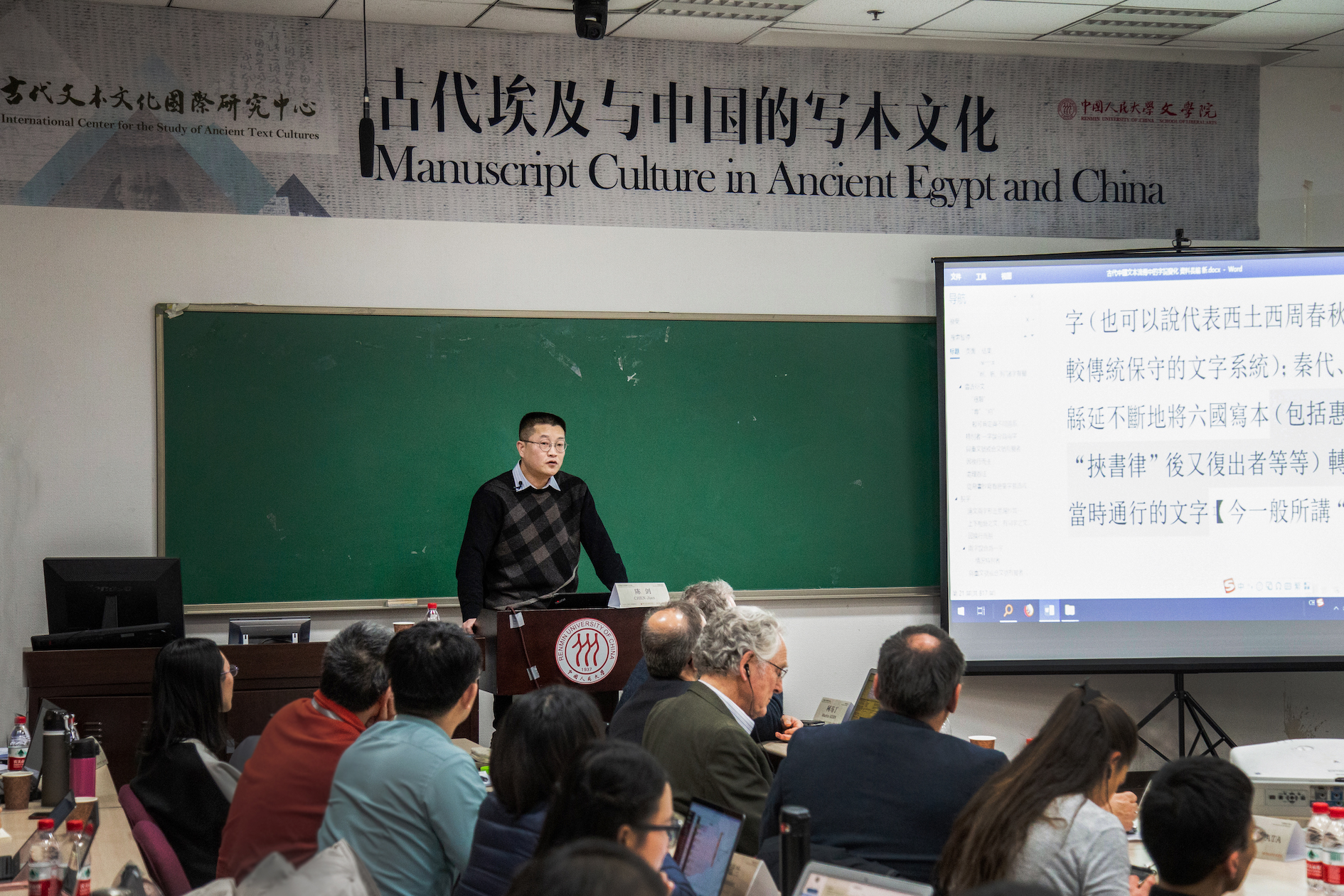
Professor Chen Jian
Professor Chen, in his second lecture, led his audience to the Mawangdui silk manuscripts excavated from tomb #3 in Changsha. The silk manuscripts can be divided into two kinds. The first kind are long silk scrolls, the second type are single flat pieces. The material for silk manuscripts were produced in pieces of single size. To produce a bigger format, two or more pieces of silk were attached to each other. Since the silk manuscripts were folded into several layers, after two millenniums of existence, the folding places are damaged or faded. That created great problems in reconstruction of the manuscripts. By carefully observing the details of the manuscripts, Professor Chen showed the audience how to put the scattered pieces of the silks back to their original places.
After four days of ancient Egypt and China lectures respectively, Professor Anthony Barbieri-Low (University of California, Santa Barbara) concluded with a speech on comparative study. He explained that History is already a comparative exercise that all knowledge is generated by comparison. To do comparative study, we should counter the hyper-specialization, bring a larger context, not only in our content, but all the manuscript culture. Comparative study also helps to generate new questions, new methods, and reframe old categories. But always remember that there is no such thing of standard accepted methodology in comparative study. Then he made a brief introduction to the current situation of comparative study between early China, Greece and Roman, on subjects of military, institution, politic, culture and so on.
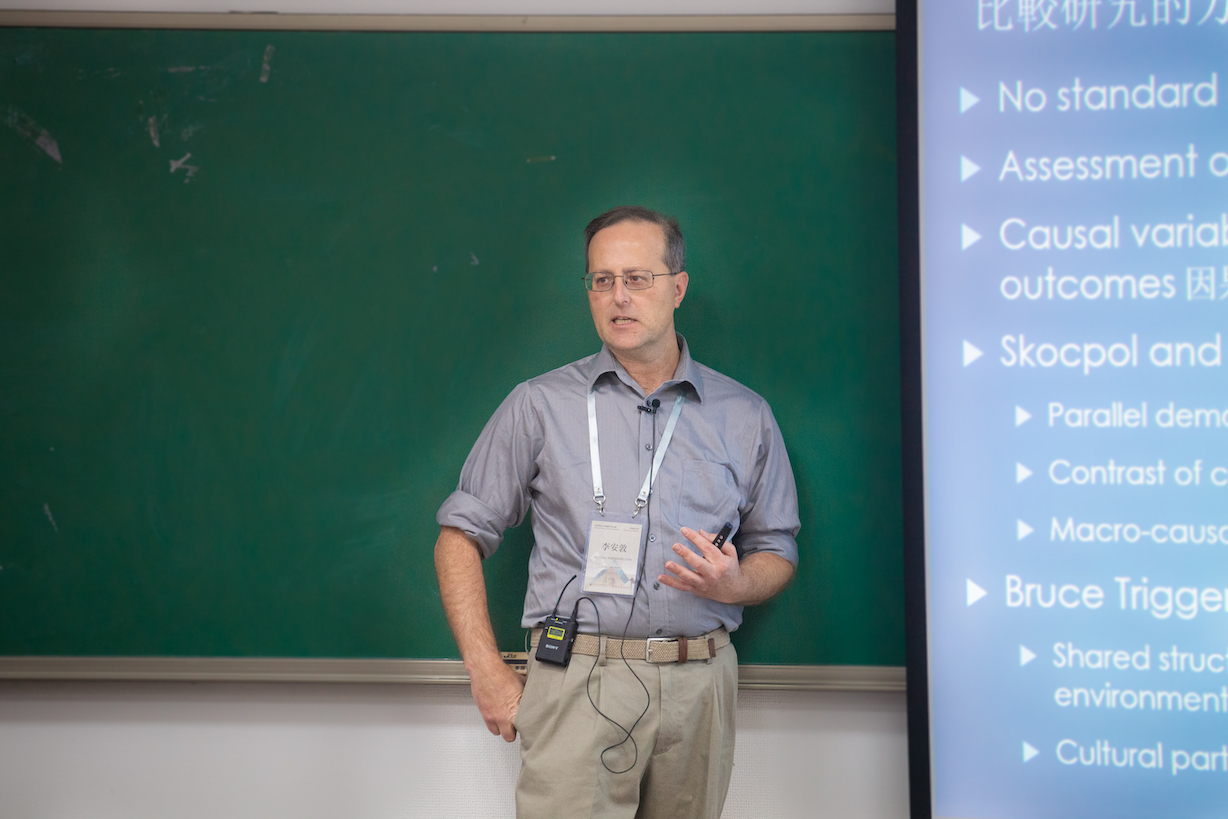
Professor Anthony Barbieri-Low
Professor Barbieri-Low argued that the subjects of comparative study don’t have to be contemporary or same time period. It would be better if they don’t. Other plausible Egypt-China comparisons include old kingdom with the late Shang period; New Kingdom with Qin and Han dynasty. One can do comparative study between any culture if he or she ask the right question and make good interpretation of context depending on the research.
Last but not least, Barbieri-Low had an overview of his new book: The Black land and the Middle Kingdom. In the first chapter, he compared the Nile and the Yellow River. By examining the nature of flooding, hydrological features of these two rivers, Barbieri-Low argued that it’s the nature of rivers determine how people see this river. He also compared legal principles between China and Egypt. In Egyptian law code, robbery, assault, rape, adultery, and possibly murder is treated as private or civil matters. Barbieri-Low then argued that the purpose of Chinese law is to teach and guide the ordinary people. It’s the blueprint of the state and more educational and didactic. That’s the reason why those crime would be punished severely according to the Chinese law.
The four-day lectures were all accompanied by lively questions and debates. Many of the audience members contributed to the discussion by introducing comparative perspectives from their own fields of specializations. On the fifth day, Ph.D. students and junior scholars were divided in small groups to present their research and academic interest, and the six instructors and their peers offered comments and professional advice. The next bi-annual workshop held by the Center will focus on author and authority in ancient world, with instructors from fields of ancient Chinese, Greece and Biblical world, June 18-21, 2019.
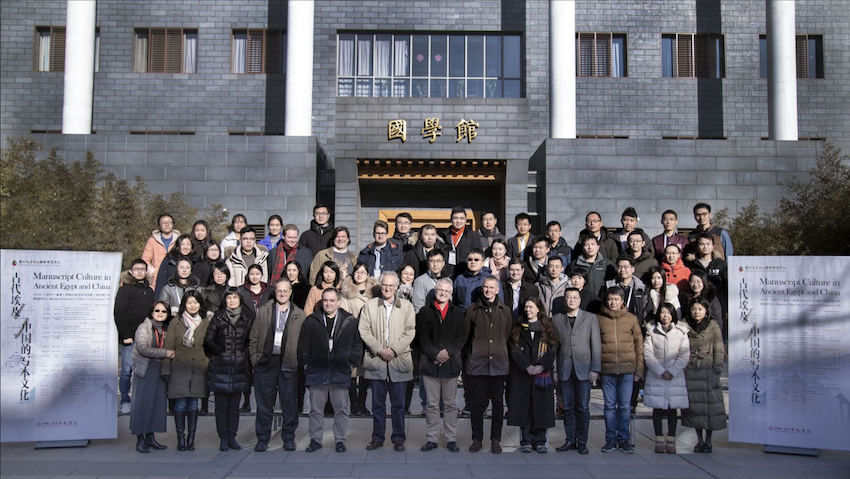
By Christian Langer M.A., Leah Mascia, Nikita Kuzmin, Benjamin Daniels, ZHAI Minhao, FENG Jing, CHEN Yongsheng, WANG Zhitian, LIU Xun, DOU Lei, Callisto Searle, Don Kuang.